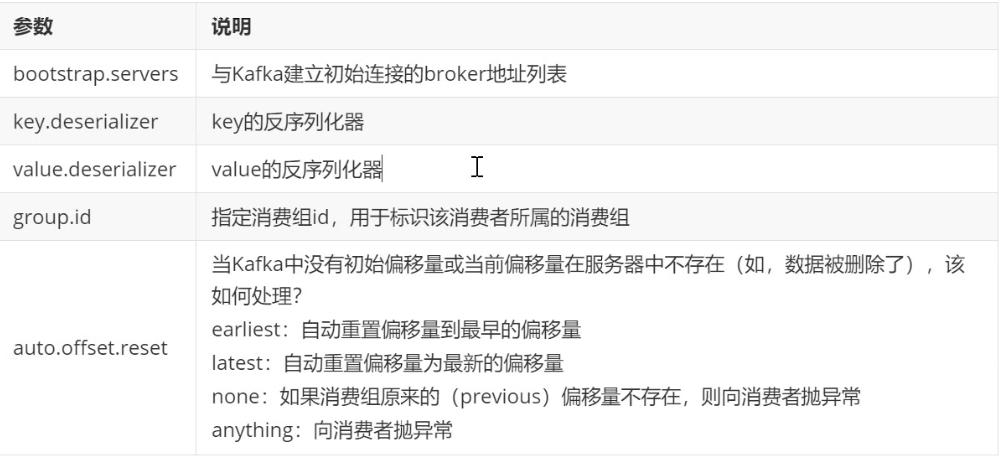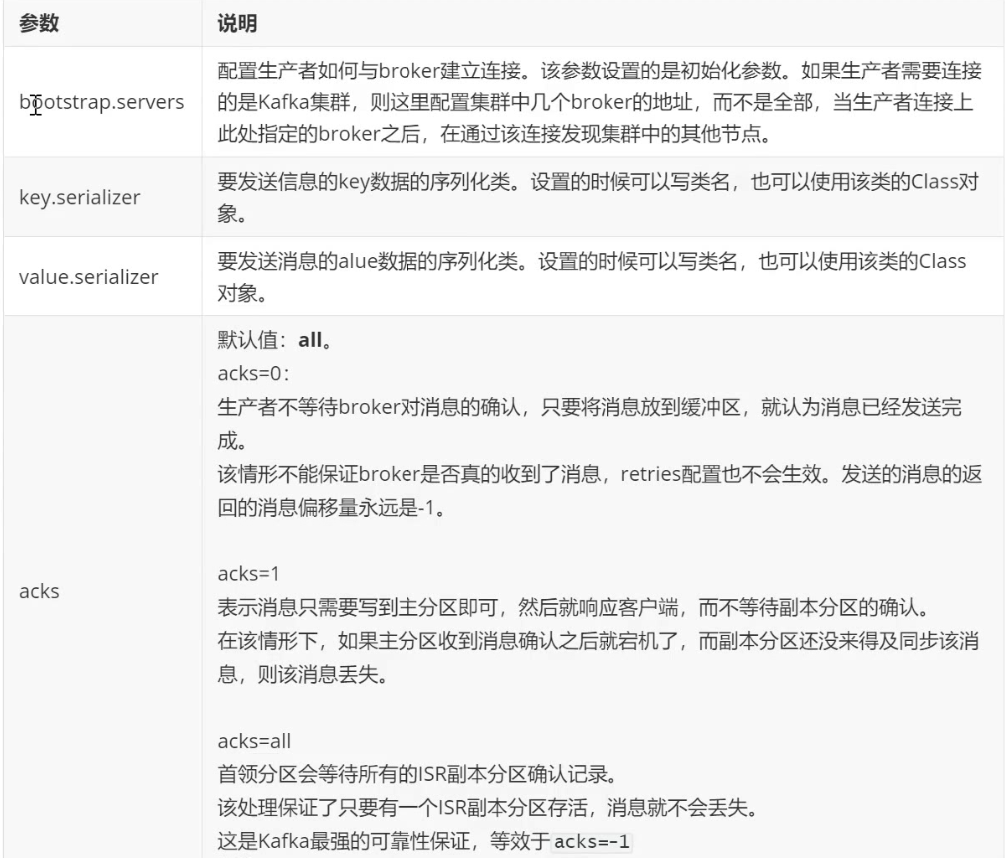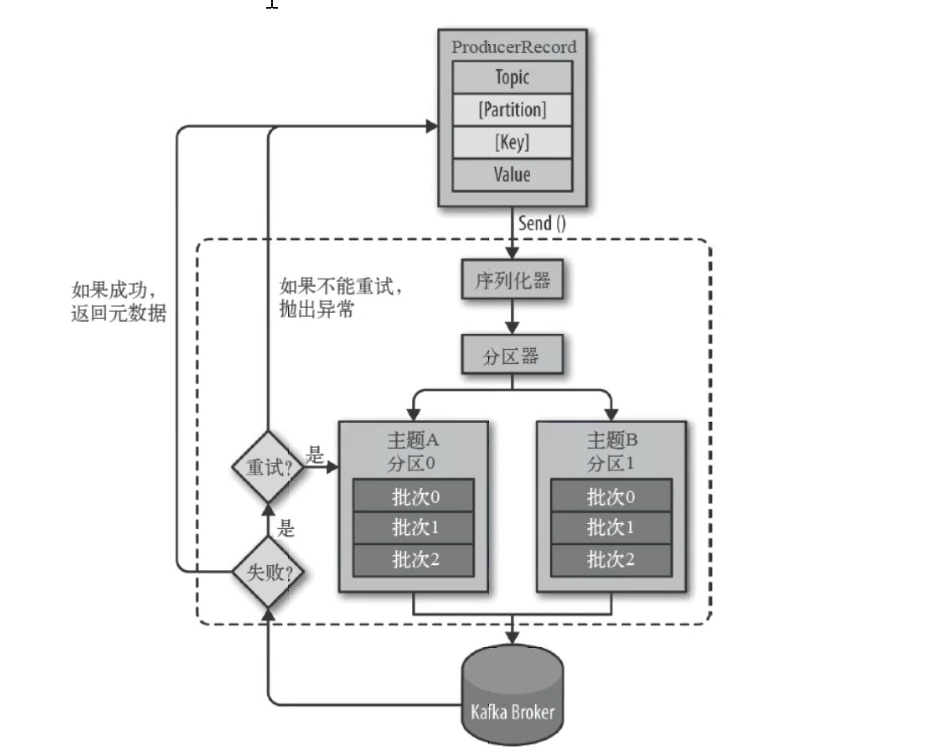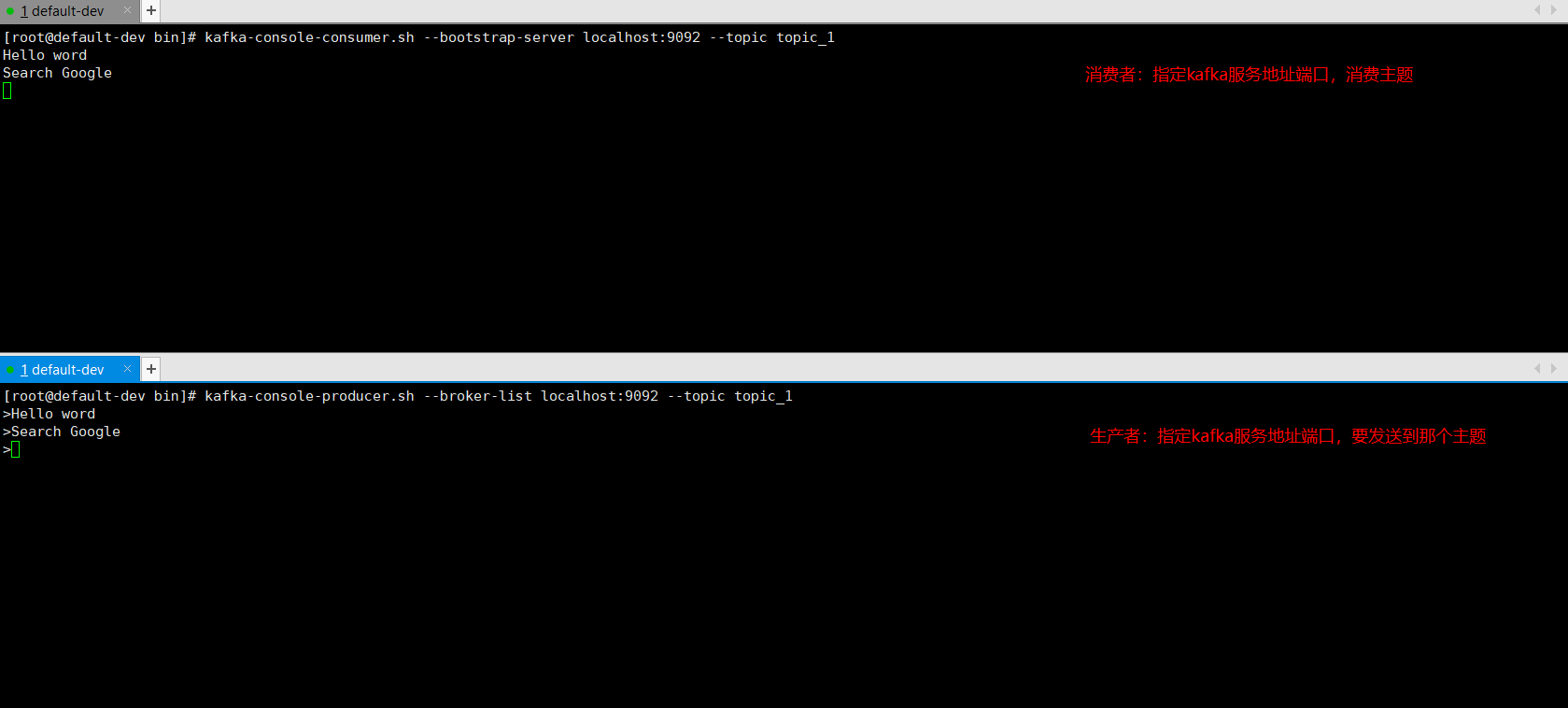环境版本说明
环境:CentOS7
版本:JDK1.8、Zookeeper-3.4.14、Kafka2.12-1.0.2
JDK安装
JDK1.8安装
rpm -ivh jdk-8u261-linux-x64.rpm环境变量配置
vim /etc/profile最后一行加上配置
export JAVA_HOME=/usr/java/jdk1.8.0_261-amd64 export PATH=$PATH:$JAVA_HOME/binjdk验证
java -version
Zookeeper安装
安装
tar -zxf zookeeper-3.4.14.tar.gz -C /opt环境变量配置
vim /etc/profileZOOKEEPER_PREFIX指向Zookeeper的解压目录
export ZOOKEEPER_PREFIX=/opt/zookeeper-3.4.14将Zookeeper的bin目录添加到PATH中
export PATH=$PATH:$ZOOKEEPER_PREFIX/bin设置环境变量ZOO_LOG_DIR,指定Zookeeper保存日志的位置
export ZOO_LOG_DIR=/var/zookeeper/log使配置生效
source /etc/profile修改zookeeper配置
cd conf cp zoo_sample.cfg zoo.cfg修改配置文件zoo.cfg
vi zoo.cfg修改zookeeper数据存放位置配置
修改前
dataDir=/tmp/zookeeper修改后
dataDir=/var/zookeeper/data启动zookeeper
进入zookeeper安装目录
=/var/zookeeper/bin启动zookeeper
zkServer.sh start查看zookeeper状态
zkServer.sh status
Kafka安装
安装kafka
tar -zxf kafka_2.12-1.0.2.tgz -C /opt修改环境变量
vi /etc/profile最后加上配置
export KAFKA_HOME=/opt/kafka_2.12-1.0.2 export PATH=$PATH:$KAFKA_HOME/bin使配置生效
source /etc/profile修改kafka配置
修改server.properties配置文件
vi server.properties修改链接zookeeper地址:123行
修改前
zookeeper.connect=localhost:2181修改后
zookeeper.connect=localhost:2181/mykafka说明:表示在zookeeper目录下会创建一个mykafka节点
修改消息持久化目录:60行
修改前
log.dirs=/tmp/kafka-logs修改后
log.dirs=/var/kafka/kafka-logs创建持久化目录文件夹
mkdir -p /var/kafka/kafka-logs
脚本说明
cd /opt/kafka_2.12-1.0.2/bin
说明:
kafka-topics.sh 操作主题的 kafka-server-start.sh kafka启动 kafka-server-stop.sh kafka关闭 kafka-console-consumer.sh 命令行里使用消费者 kafka-console-producer.sh 命令行里面使用的生产者启动kafka
注意是进入到bin目录下的
kafka-server-start.sh ../config/server.properties客户端测试
使用zookeeper客户端登录zookeeper,复制启动窗口执行zkCli.sh。(注意:必须复制服务器启动窗口来执行,不然没有脚本。)
zkCli.sh查看zookeeper的根节点

ls /查看mykafka
ls /mykafka
说明:
cluster 集群 controller 控制器 controller_epoch 控制器纪元数据 brokers broker admin 管理者 isr_change_notification 同步的副本 consumers 消费者 log_dir_event_notification log_dir事件通知 latest_producer_id_block 最后一个生产者 config 配置客户端退出zookeeper
quit
关闭kafka
kafka-server-stop.sh
主题
后台启动kafka
kafka-server-start.sh -daemon /opt/kafka_2.12-1.0.2/config/server.properties查看kafka进程信息
ps aux | grep kafka主题脚本使用帮助,直接执行脚本,显示主题脚本使用参数。
kafka-topics.sh使用参数如下:
[root@default-dev bin]# kafka-topics.sh Create, delete, describe, or change a topic. Option Description ------ ----------- --alter Alter the number of partitions, replica assignment, and/or configuration for the topic. --config <String: name=value> A topic configuration override for the topic being created or altered.The following is a list of valid configurations: cleanup.policy compression.type delete.retention.ms file.delete.delay.ms flush.messages flush.ms follower.replication.throttled. replicas index.interval.bytes leader.replication.throttled.replicas max.message.bytes message.format.version message.timestamp.difference.max.ms message.timestamp.type min.cleanable.dirty.ratio min.compaction.lag.ms min.insync.replicas preallocate retention.bytes retention.ms segment.bytes segment.index.bytes segment.jitter.ms segment.ms unclean.leader.election.enable See the Kafka documentation for full details on the topic configs. --create Create a new topic. --delete Delete a topic --delete-config <String: name> A topic configuration override to be removed for an existing topic (see the list of configurations under the --config option). --describe List details for the given topics. --disable-rack-aware Disable rack aware replica assignment --force Suppress console prompts --help Print usage information. --if-exists if set when altering or deleting topics, the action will only execute if the topic exists --if-not-exists if set when creating topics, the action will only execute if the topic does not already exist --list List all available topics. --partitions <Integer: # of partitions> The number of partitions for the topic being created or altered (WARNING: If partitions are increased for a topic that has a key, the partition logic or ordering of the messages will be affected --replica-assignment <String: A list of manual partition-to-broker broker_id_for_part1_replica1 : assignments for the topic being broker_id_for_part1_replica2 , created or altered. broker_id_for_part2_replica1 : broker_id_for_part2_replica2 , ...> --replication-factor <Integer: The replication factor for each replication factor> partition in the topic being created. --topic <String: topic> The topic to be create, alter or describe. Can also accept a regular expression except for --create option --topics-with-overrides if set when describing topics, only show topics that have overridden configs --unavailable-partitions if set when describing topics, only show partitions whose leader is not available --under-replicated-partitions if set when describing topics, only show under replicated partitions --zookeeper <String: urls> REQUIRED: The connection string for the zookeeper connection in the form host:port. Multiple URLS can be given to allow fail-over.注意:REQUIRED为必选参数,如上面的--zookeeper链接地址。
查看所有可用主题
kafka-topics.sh --zookeeper localhost:2181/mykafka --list创建主题
kafka-topics.sh --zookeeper localhost/mykafka --create --topic topic_1 --partitions 1 --replication-factor 1说明:zookeeper端口可省略,使用的是默认的。
--topic: 创建主题名字
--partitions:创建几个分区,便于横向扩展。
--replication-factor:一个分区创建几个副本,高可用。
注意:当只有一个服务一个broker时,是没有意义的,当服务宕机了,数据也没了。因此--replication-factor副本必须在不同的kafka服务器上,才能实现高可用。
再次查看可用主题
kafka-topics.sh --zookeeper localhost:2181/mykafka --list
查看主题详细信息
kafka-topics.sh --zookeeper localhost/mykafka --describe --topic topic_1
说明:topic_1有一个0号分区,在0号服务器上。
实例
创建一个topc_2主题,5个分区,每个分区1个副本.
kafka-topics.sh --zookeeper localhost/mykafka --create --topic topic_2 --partitions 5 --replication-factor 1查看可用主题
kafka-topics.sh --zookeeper localhost:2181/mykafka --list
查看topic_2主题详情
kafka-topics.sh --zookeeper localhost/mykafka --describe --topic topic_2
说明:5个分区都在0号服务器上。
消费
消费脚本使用帮助:
kafka-console-consumer.sh使用参数:
The console consumer is a tool that reads data from Kafka and outputs it to standard output.
Option Description
------ -----------
--blacklist <String: blacklist> Blacklist of topics to exclude from
consumption.
--bootstrap-server <String: server to REQUIRED (unless old consumer is
connect to> used): The server to connect to.
--consumer-property <String: A mechanism to pass user-defined
consumer_prop> properties in the form key=value to
the consumer.
--consumer.config <String: config file> Consumer config properties file. Note
that [consumer-property] takes
precedence over this config.
--csv-reporter-enabled If set, the CSV metrics reporter will
be enabled
--delete-consumer-offsets If specified, the consumer path in
zookeeper is deleted when starting up
--enable-systest-events Log lifecycle events of the consumer
in addition to logging consumed
messages. (This is specific for
system tests.)
--formatter <String: class> The name of a class to use for
formatting kafka messages for
display. (default: kafka.tools.
DefaultMessageFormatter)
--from-beginning If the consumer does not already have
an established offset to consume
from, start with the earliest
message present in the log rather
than the latest message.
--group <String: consumer group id> The consumer group id of the consumer.
--isolation-level <String> Set to read_committed in order to
filter out transactional messages
which are not committed. Set to
read_uncommittedto read all
messages. (default: read_uncommitted)
--key-deserializer <String:
deserializer for key>
--max-messages <Integer: num_messages> The maximum number of messages to
consume before exiting. If not set,
consumption is continual.
--metrics-dir <String: metrics If csv-reporter-enable is set, and
directory> this parameter isset, the csv
metrics will be output here
--new-consumer Use the new consumer implementation.
This is the default, so this option
is deprecated and will be removed in
a future release.
--offset <String: consume offset> The offset id to consume from (a non-
negative number), or 'earliest'
which means from beginning, or
'latest' which means from end
(default: latest)
--partition <Integer: partition> The partition to consume from.
Consumption starts from the end of
the partition unless '--offset' is
specified.
--property <String: prop> The properties to initialize the
message formatter.
--skip-message-on-error If there is an error when processing a
message, skip it instead of halt.
--timeout-ms <Integer: timeout_ms> If specified, exit if no message is
available for consumption for the
specified interval.
--topic <String: topic> The topic id to consume on.
--value-deserializer <String:
deserializer for values>
--whitelist <String: whitelist> Whitelist of topics to include for
consumption.
--zookeeper <String: urls> REQUIRED (only when using old
consumer): The connection string for
the zookeeper connection in the form
host:port. Multiple URLS can be
given to allow fail-over. REQUIRED:必填参数
unless old consumer is used:使用老消费者
--bootstrap-server <String: server to REQUIRED (unless old consumer is
connect to> used): The server to connect to. only when using old consumer:使用旧消费时使用
--zookeeper <String: urls> REQUIRED (only when using old
consumer): The connection string for
the zookeeper connection in the form
host:port. Multiple URLS can be
given to allow fail-over.消费者消费
链接Kafka服务端,当有多台Kafka时,只需要链接其中一台服务即可。注意,消费者消费端口是9092了。
kafka-console-consumer.sh --bootstrap-server localhost:9092 --topic topic_1说明:
--bootstrap-server localhost:9092:指定kafka服务地址端口
--topic topic_1:指定消费的主题
测试界面像是卡住了,不管。
消费者API使用参数配置说明

生产
生产脚本使用帮助
kafka-console-producer.sh使用参数:
Read data from standard input and publish it to Kafka.
Option Description
------ -----------
--batch-size <Integer: size> Number of messages to send in a single
batch if they are not being sent
synchronously. (default: 200)
--broker-list <String: broker-list> REQUIRED: The broker list string in
the form HOST1:PORT1,HOST2:PORT2.
--compression-codec [String: The compression codec: either 'none',
compression-codec] 'gzip', 'snappy', or 'lz4'.If
specified without value, then it
defaults to 'gzip'
--key-serializer <String: The class name of the message encoder
encoder_class> implementation to use for
serializing keys. (default: kafka.
serializer.DefaultEncoder)
--line-reader <String: reader_class> The class name of the class to use for
reading lines from standard in. By
default each line is read as a
separate message. (default: kafka.
tools.
ConsoleProducer$LineMessageReader)
--max-block-ms <Long: max block on The max time that the producer will
send> block for during a send request
(default: 60000)
--max-memory-bytes <Long: total memory The total memory used by the producer
in bytes> to buffer records waiting to be sent
to the server. (default: 33554432)
--max-partition-memory-bytes <Long: The buffer size allocated for a
memory in bytes per partition> partition. When records are received
which are smaller than this size the
producer will attempt to
optimistically group them together
until this size is reached.
(default: 16384)
--message-send-max-retries <Integer> Brokers can fail receiving the message
for multiple reasons, and being
unavailable transiently is just one
of them. This property specifies the
number of retires before the
producer give up and drop this
message. (default: 3)
--metadata-expiry-ms <Long: metadata The period of time in milliseconds
expiration interval> after which we force a refresh of
metadata even if we haven't seen any
leadership changes. (default: 300000)
--old-producer Use the old producer implementation.
--producer-property <String: A mechanism to pass user-defined
producer_prop> properties in the form key=value to
the producer.
--producer.config <String: config file> Producer config properties file. Note
that [producer-property] takes
precedence over this config.
--property <String: prop> A mechanism to pass user-defined
properties in the form key=value to
the message reader. This allows
custom configuration for a user-
defined message reader.
--queue-enqueuetimeout-ms <Integer: Timeout for event enqueue (default:
queue enqueuetimeout ms> 2147483647)
--queue-size <Integer: queue_size> If set and the producer is running in
asynchronous mode, this gives the
maximum amount of messages will
queue awaiting sufficient batch
size. (default: 10000)
--request-required-acks <String: The required acks of the producer
request required acks> requests (default: 1)
--request-timeout-ms <Integer: request The ack timeout of the producer
timeout ms> requests. Value must be non-negative
and non-zero (default: 1500)
--retry-backoff-ms <Integer> Before each retry, the producer
refreshes the metadata of relevant
topics. Since leader election takes
a bit of time, this property
specifies the amount of time that
the producer waits before refreshing
the metadata. (default: 100)
--socket-buffer-size <Integer: size> The size of the tcp RECV size.
(default: 102400)
--sync If set message send requests to the
brokers are synchronously, one at a
time as they arrive.
--timeout <Integer: timeout_ms> If set and the producer is running in
asynchronous mode, this gives the
maximum amount of time a message
will queue awaiting sufficient batch
size. The value is given in ms.
(default: 1000)
--topic <String: topic> REQUIRED: The topic id to produce
messages to.
--value-serializer <String: The class name of the message encoder
encoder_class> implementation to use for
serializing values. (default: kafka.
serializer.DefaultEncoder) 注意:REQUIRED必填参数
生产者链接kafka服务
kafka-console-producer.sh --broker-list localhost:9092 --topic topic_1说明:
--broker-list:指定broker,如果有很多太kafka服务器,只需要指定2个地址接口,这里只有一台kafka服务器,只指定一个。
--topic:指定要发送消息到那个topic主题。
此时生产者窗口也像卡住了,说明进入了发送消息界面。
生产者API使用参数配置说明


消息发送接收测试
注意:提示如下信息检查主题名称是否错误
WARN [Producer clientId=console-producer] Error while fetching metadata with correlation id 8可查看可用主题:明确消费主题和生产者是否是使用的一个主题。
kafka-topics.sh --zookeeper localhost:2181/mykafka --list消息的发送与接受

测试结果:

注意:当关闭消费者后,生产者继续发送消息,当生产者重新链接后,只能接受到后面生产者重新发送的消息。
消费历史消息
如果要消费以前的消息可以指定参数--from-beginning
kafka-console-consumer.sh --bootstrap-server localhost:9092 --topic topic_1 --from-beginning查看持久化数据
ca /var/kafka/kafka-logs
可以看到很多偏移量的文件。
服务端参数配置
主要是服务器kafka配置文件server.properties的配置
zookeeper.connect

该参数用于配置kafka要链接的Zookeeper/集群地址。
它的值是一个字符串,使用都好分割zookeeper的多个地址。Zookeeper的单个地址是host:port形式的,可以在最后添加kafka在zookeeper中的根节点路径。
例如:
zookeeper.connect=192.1681.1:2181,192.1681.2:2181,192.1681.3:2181,192.1681.4:2181/mykafka最好服务器地址数量过半,后面zookeeper存放路径/mykafka写一个就好了。
listeners

用于指定当前Broker向外发布服务的地址和端口。
与advertised.listeners配合,用于做内外网隔离。
注意:端口号也是可以修改的。
内外网隔离配置
listeners
用于配置broker监听的URL以及监听器名称列表,使用逗号隔开多个URL及监听器名称。
例如:服务器有2个ip,ip如下

则配置如下:

listeners配置:注意监听器名称不能相同,端口不能相同。PLAINTEXT代表了都使用PLAINTEXT协议,也代表了监听器的名称,但是名称又不能相同,因此使用映射配置参数listner.sercurity.protocol.map。
加上上面配置后,启动还是会报错,因此必须加上如下配置:

整体说明:注意kafka是使用的PLAINTEXT协议
listener.security.protocol.map=INTERNAL:PLAINTEXT,EXTERNAL:PLAINTEXT
listeners=INTERNAL://10.0.2.15:9000,EXTERNAL://192.168.56.30:9001
advertised.listeners=EXTERNAL://192.168.56.30:9001
inter.broker.listener.name=EXTERNALlistener.security.protocol.map:解决监听协议、监听器名称一样问题。
listeners:集群多台服务地址
advertised.listeners:暴露给消费者生产者,以及节点间通讯使用的地址和端口(需要将该地址发布到zookeeper供客户端使用,如果客户端使用的地址与listeners配置不同),而另一个地址端口INTERNAL://10.0.2.15:9000则可用于内部管理kafka。
inter.broker.listener.name:暴力给消费者生产者使用监听的监听器名称,如果要暴露多个直接可以逗号隔开多加几个,前提是listeners里面有的。
listener.security.protocol.map
用于内外网隔离配置,监听器名称和安全协议的映射配置。
例如:将内外网隔离,即使他们都使用SSL,上面的配置问题就可以加下面参数解决。
listener.security.protocol.map=INTERNAL:SSL,EXTERNAL:SSL说明:
INTERNAL,EXTERNAL:代表监听器名称
SSL:代表都是使用SSL协议。
加上这个参数配置,就可以解决上面的监听器名称和协议冲突的问题了。
注意:每个监听器的名称只能在map中出现一次。如果监听器名称代表的不是安全协议,必须配置listener.security.protocol.map。
每个监听器必须使用不同的网络端口。
查看zoopeeper信息:
客户端脚本链接zookeeper:
zkCli.sh查看kafka信息
get /mykafka/brokers/ids/0
查看可用主题:
kafka-topics.sh --zookeeper localhost:2181/mykafka --listbroker.id
该属性用于唯一标记一个kafka的Broker,它的值是一个任意integer值。
当kafka以分布式集群部署使用时,非常重要。最好该值只跟该Broker所在的物理主机有关的,如主机名为host1.yanxizhu.com,则broker.id=1,如果主机名为192.168.56.30,则broker.id=30.
log.dir
通过该属性的值,指定kafka在磁盘上保存消息的日志片段的目录。
它时一组用逗号分隔的本地文件系统路径。
如果指定了多个路径,那么broker会根据”最少使用“原则,把同一个分区的日志片段保存到同一个路径下。
broker会往拥有最少数目分区的路径新增分区,而不是往拥有最小磁盘空间的路径新增分区。






评论 (0)